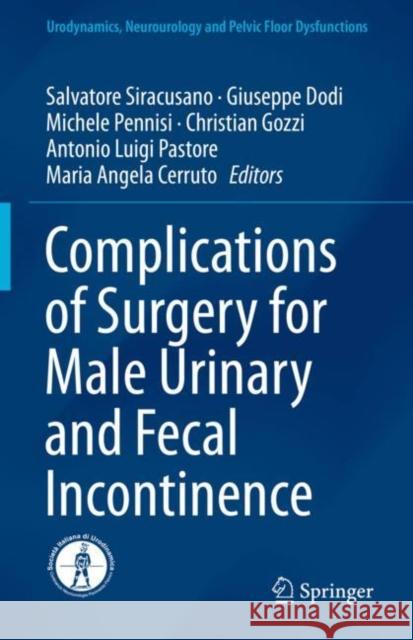Complications of Surgery for Male Urinary and Fecal Incontinence » książka



Complications of Surgery for Male Urinary and Fecal Incontinence
ISBN-13: 9783319982632 / Angielski / Twarda / 2020 / 167 str.
Complications of Surgery for Male Urinary and Fecal Incontinence
ISBN-13: 9783319982632 / Angielski / Twarda / 2020 / 167 str.
(netto: 191,66 VAT: 5%)
Najniższa cena z 30 dni: 192,74
ok. 22 dni roboczych
Bez gwarancji dostawy przed świętami
Darmowa dostawa!
PART I INTRODUCTORY REMARKS Chapter 1 Epidemiology of Male Urinary Incontinence.- Chapter 2 Epidemiology of Fecal Incontinence.- Chapter 3 Surgical Anatomy, Physiology and Pathophysiology of Lower Urinary Tract.- Chapter 4 Surgical Anatomy, Physiology and Pathophysiology of the Terminal Tract of the Large Intestine.- Chapter 5 Urinary and Fecal Incontinence: Preoperative Considerations.- Chapter 6 Fecal Incontinence: Preoperative Considerations.- PART II SURGICAL PROCEDURES AND INTRAOPERATIVE COMPLICATIONS Chapter 7 Artificial Urinary Sphincter (AUS): Surgical Procedures and Intraoperative Complications.- Chapter 8 Artificial Anal Sphincter: Surgical Procedure and Intraoperative Complications.- Chapter 9 Procedures and Intraoperative Complications of Slings for Urinary Incontinence.- Chapter 10 Slings for Faecal Incontinence: Surgical Procedure and Intraoperative Complications.- Chapter 11 ProACT for Urinary Incontinence: Surgical Technique and Intraoperative Complications.- Chapter 12 Bulking Agents for Urinary Incontinence: Surgical Procedure and Intraoperative Complications.- Chapter 13 Bulking Agents for Fecal Incontinence: Surgical Procedure and Intraoperative Complications.- Chapter 14 Sacral Neuromodulation for Urinary Incontinence: Surgical Procedure and Intraoperative Complications.- Chapter 15 Sacral Nerve Modulation: Surgical Procedure and Intraoperative Complications.- Chapter 16 Anal Sphincter Reconstruction and Graciloplasty.- Chapter 17 Radiofrequency (SECCA) for Fecal Incontinence: Procedure and Intraoperative Complications.- PART III SHORT, INTERMEDIATE AND LONG-TERM POSTOPERATIVE COMPLICATIONS Chapter 18 Artificial Urinary Sphincter (AUS): Short, Intermediate and Long-Term Postoperative Complications.- Chapter 19 Artificial Anal Sphincter: Short, Intermediate and Long Term Post-Operative Complications.- Chapter 20 Complications of Anal Sphincter Reconstruction and Graciloplasty.- Chapter 21 Short, Intermediate and Long-Term Postoperative Complications of Slings for Urinary Incontinence.- Chapter 22 Slings for Faecal Incontinence: Short, Intermediate and Long-Term Postoperative Complications.- Chapter 23 Bulking Agents for Fecal Incontinence: Short, Intermediate and Long-Term Postoperative Complications.- Chapter 24 Postoperative Complications of Sacral Neuromodulation for Fecal Incontinence.- Chapter 25 A Complication in SECCA Procedure: Case of Anal Abscess.
Salvatore Siracusano is Associate Professor of Urology at the Medical School of the University of Verona (Italy). He deals mainly with uro-oncological and functional surgery with particular reference to urinary incontinence for men and women. He belongs to EAU section of oncological urology (ESOU) and to EAU section of ESUI board as Associate member. Since 2010 he held the position of examiner at European Board of Urology (EBU). In 2014 he obtained suitability to hold the role of a full Professor in urology. He is author of numerous peer reviewed publications and he is member of the most important international urological scientific societies.
Giuseppe Dodi, Associate Professor of Surgery in the Department of Surgical Sciences in Oncology and Gastroenterology, University of Padua (1985-2016), founding member of the Italian Society of ColoRectal Surgery and of the International Society for Pelvi-Perineology, member of the American Society of Colon and Rectal Surgeons, Author of textbooks and international publications, Chief Editor of the journal Pelviperineology. Main areas of clinical experience and research are colorectal and pelvic floor pathophysiology and surgery.
Michele Pennisi is Chief of Urology and of Neuro-Urology Unit at Cannizzaro Hospital of Catania. He deals mainly with uro-oncological and functional surgery with particular reference to urinary incontinence for men and women. He is author of numerous peer reviewed publications and he is member of the most important international urological scientific societies.
Antonio Luigi Pastore is Assistant Professor at Sapienza University of Rome (Italy). His main areas of clinical experience and scientific research are uro-oncology, functional urology and andrology. He is Author of more than 100 publications and he is member of the most important national and international urologic societies.
Christian Gozzi is an urologist of German-Austrian school. He is the ideator and co-inventor of the Advance male sling, the first Transobturator sling, and an expert of urethral reconstructive surgery, member of the GURS. Actually he is visiting professor at the Urologist school of Pisa's University, consultant for incontinence and urethral surgery at Santa Maria clinic in Bolzano, Bios in Roma, San Raffaele Hospital in Milano and Beau Site Clinic in Bern. He is author and co-worker in more than 70 scientific papers.
Maria Angela Cerruto is Assistant Professor in Urology at the University School of Verona. She is member of several national and international societies: EAU, SIU, SIUD, ICS. She is acupuncturist. From June 2007 she is Fellow of the European Board of Urology (FEBU). She is reviewer of the following international Journals: Fertility & Sterility, World Journal of Urology, Hormones, BJU Int. From 2006 she is Urology Professor at the degree course in Physiotherapy, Verona University. She participated in several national and/or international urological congresses/meetings as well as in national and/or international urological courses. She presented many oral communications/poster presentations in national and/or international congresses/meetings as well as presentations as invited speakers in national and/or international congresses. She collaborated to the layout of several book chapters. She is author/coauthor of 81 publications on both national and international journals.
This text provides a comprehensive and multidisciplinary, state-of-the-art review of complications related to surgical procedures for male urinary and fecal incontinence. As surgery has evolved over the decades, newer and at times unexpected intraoperative and long-term complications have arisen. Specialists who are unfamiliar with them need to know how to manage these specific complications and, more importantly, how to avoid them in the course of their future practice.
This volume provides an essential guide for all urologists, proctologists and surgeons operating on male patients with urinary and fecal incontinence.
1997-2025 DolnySlask.com Agencja Internetowa
KrainaKsiazek.PL - Księgarnia Internetowa









